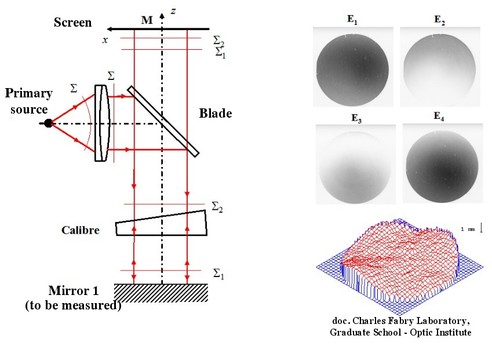
Fizeau Interferometer
A Fizeau interferometer is composed of a source of light, of a collimator, of a reflecting plane mirror, of a half-reflecting blade, of a gauge and of a screen (figure 14). The “gauge” is a glass corner whose sides are perfectly flat and whose face exposed to the plane mirror represents the interferometer second plane mirror. The light reflected on the angle side is suppressed and does not go back to the screen.

Figure 14 (right part) shows an application of Fizeau's interferometer to plane surfaces control with nanometric accuracy, using the phase difference method (
 : interferogram with phase difference of
: interferogram with phase difference of
 )
)
Because of its geometry, when we switch mirror 1 of an angle
 , interferences fringes observed with the Fizeau equal those of figure 12.
, interferences fringes observed with the Fizeau equal those of figure 12.
As the air thickness crossed back and forth in the Fizeau can be reduced to a thin air stratum moving both surfaces closer together, that interferometer presents a great advantage for the high precision metrology in comparison with Michelson and Mach-Zahnder ones. Indeed, the air thicknesses crossed in both arms of both interferometers are very large and above all separated so that those interferometers are very sensitive to any disturbance and to the stratification of the air stratum index.